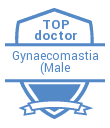Contact us today to schedule your appointment!
-
Call Us at +91-96000-58899
-
Call Us at +91-94440-35171
-
Call on Viber +91-89395-02777
-
Chat on WhatsApp +91-89395-02777
-
Chat on Telegram +91-96000-58899
-
Contact us today to schedule your appointment!
Jump To
Chennai Plastic Surgery offers breast reduction surgery in India to help women experiencing mild to severe breast enlargement caused by overdeveloped milk glands, excess fat tissue, or a combination of both. Large breasts can lead to breast reduction for back pain, neck pain, shoulder strain, breathing difficulties, sleep disturbances, and poor posture. Additionally, sagging due to gravity can make the breasts aesthetically unappealing and physically uncomfortable.
Breast skin volume is permanent and cannot be reversed through weight loss alone. Non–surgical procedure options provide minimal relief and are not a permanent solution. For women seeking relief due to discomfort, surgical intervention remains the most effective option.
Reduction mammoplasty in India is a safe breast reduction procedure that removes excess glandular tissue, fat, and skin to achieve a breast size more proportionate to the body. This procedure helps alleviate discomfort, restore mobility, and improve self-confidence. By reshaping the breast, reduction mammoplasty enhances both function and appearance, making everyday activities more comfortable.
Women with disproportionately large breasts may face chronic pain, difficulty exercising, and emotional distress. Many experience breast reduction for back pain, shoulder and neck pain, as well as skin irritation from rashes under the breasts or deep indentations from bra straps. Heavy breasts can restrict physical activity, limit clothing options, and reduce self-confidence. Breast reduction surgery not only provides physical relief but also improves overall well-being.
Once you have consulted a board-certified plastic surgeon and have decided to get the procedure done, you will be required to do the following:
You should be advised to fast for eight hours before the surgery.
Depending on your breast size, skin elasticity, and desired results, different surgical techniques are used:
The procedure will be done usually under general anesthesia.
Regardless of the approach, the nipple-areola complex is repositioned while maintaining blood and nerve function. The procedure is designed to preserve natural symmetry and long-term breast function.
Patients will be shifted to the post-operative ward, where trained staff will closely monitor them. Most patients can be discharged on the same day. Those with comorbid conditions may be asked to stay overnight for observation.
Post-procedure dressings will be applied over the incision lines. Patients will be discharged with oral antibiotics and painkillers for five to seven days. The first follow-up would be after 48 hours. Dressings will be changed, and the patient will be asked to wear a sports bra to support the breasts and minimize swelling.
The sutures will be removed on the seventh day after surgery. One can resume normal daily activities from the third day. Patients can resume their routine in a week and start mild exercises by the second week. Restriction of cardio for three weeks and muscle workouts for six weeks is advised. Vigorous exercises and swimming should preferably be resumed only by week six.
The cost of breast reduction in India varies depending on factors such as surgical technique, the complexity of the procedure, anesthesia, hospital stay duration, and post-operative care. Chennai Plastic Surgery provides affordable cosmetic surgery in India, offering top-quality care at competitive pricing. Our team ensures that every patient receives personalized treatment and guidance.
At Chennai Plastic Surgery, our top priorities are patient care and surgical excellence. Our practice is known for providing safe breast reduction procedures with consistently high patient satisfaction rates. The team is led by some of the best breast reduction surgeons in India, ensuring that every procedure is conducted with precision and expertise.
Each patient receives a treatment plan tailored to their needs and desired outcomes. The clinic offers affordable cosmetic surgery in India, making quality procedures accessible to everyone. Comprehensive pre-operative and post-operative care ensures a smooth experience, focusing on safety, comfort, and long-term satisfaction.
Choosing Chennai Plastic Surgery means entrusting your procedure to a team with a proven track record of successful outcomes. Whether addressing physical discomfort or aesthetic concerns, our dedication to excellence ensures that patients receive the highest standard of care.
For more information on breast reduction surgery in India, schedule an appointment today or click on the QR code below. We will let you know if you are a good candidate for the procedure and can recommend any additional treatments that can help you reach your beauty goals.
Several patients experience temporary loss in breast sensitivity after Mastopexy. This is because the nerve endings were cut during the operation and needed to heal over time, sometimes several months, for the normal sensation to return. In some rare cases, the procedure can lead to a permanent loss of sensation in the breasts and/or areola area.
Any injury results in scars. And Mastopexy is no exception. But, these scars are usually not problematic. A lowdown on the kinds of scars:
Smokers or those who have a medical history of abnormal scarring are at greater risk for developing more apparent breast lift scars. Scar gels and silicone gel sheeting can help minimize scarring. It’s important to remember that scarring looks worse just after surgery and begins fading over time.
Revision surgery isn’t usually required to treat wound separation. Smokers and diabetics are among those who may experience separation of the operating wound edges. If wounds do separate, take care to keep the area as clean as possible. Women who experience wound separation will take longer to recover completely from their Mastopexy.
Due to the effects on blood circulation during a breast lift, there is a risk that part of the breast skin, or the nipple, could turn black. This risk is much higher, however, in diabetics and smokers, and for this reason, Mastopexy surgery is not performed on these patients.
Naturally, all women have some level of asymmetry. When this asymmetry is noticeable and causes distress and discomfort, surgery must be performed to correct it and achieve a more balanced look.
Although not common, excessive blood loss may require a blood transfusion. If the bleeding fails to stop independently, it needs immediate medical attention. To reduce the risk of postoperative bleeding, patients are instructed to avoid the use of anticoagulant medications and supplements like vitamin E, garlic tablets, and aspirin.
A hematoma is caused by blood collecting and clotting in a body cavity. It could cause swelling, pain, develop scar tissue, infections and other complications. Patients would know a hematoma has developed when one breast becomes significantly bigger than the other, even 2-3 times bigger! It would also become very painful – a sure sign that the doctor must know and medical care must be administered immediately.
When fat lacks a proper blood supply, it becomes necrotic or perishes. The affected tissue turns orange and begins to weep. This is a problem and could lead to major infections. Patients must seek immediate treatment to remove the necrotic tissue. However, it is a rare occurrence in breast tissue and can be seen in smokers, women who suffer from diabetes, or circulatory problems. Those who have undergone radioactive/chemotherapy treatment are at an increased risk of developing necrosis.
Normally, infections show up within three days following surgery. The signs are severe swelling, redness, significant pain that shows no sign of improvement, discharge, a foul smell, a fever of 38 degrees Celsius or higher, and intense heat stemming from the operated area.
Dissatisfaction will not occur if patients have realistic expectations from their breast lift surgery. In any surgery, skin is cut. Therefore, scarring is a given. You need to accept that in your mind. Anyway, these scars are never visible in public. When you know what to expect, you automatically keep your expectations real. And we at Chennai Plastic Surgery are known to exceed expectations positively.








